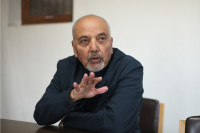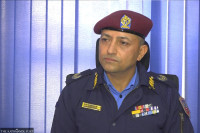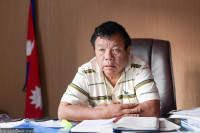Interviews
Mengistu Alemayehu: If Nepal is politically stable, IFC will do more than what it already has
The Regional Director for International Finance Corporation opens up about the Upper Trishuli-1 Hydropower Project and how it can create new markets..jpg&w=900&height=601)
Avasna Pandey
Last week, the Nepal water and energy development company signed a deal with nine international banks and financial institutions in what is the largest foreign direct investment (FDI) in the hydropower sector. The Upper Trishuli-1 Hydropower Project is designed to generate annual energy of 1,533 GWh from three power generating units of total installed capacity of 216 MW. Out of a total loan amount of $453.2 million for the project, loans amounting to $161.3 million are from the International Finance Corporation. The Post’s Avasna Pandey met with Mengistu Alemayehu, IFC regional director, to discuss how this project is different from all other hydropower projects and the other areas where the IFC will invest in Nepal in its quest to create jobs and markets.
This interview has been condensed for clarity.
Upper Trishuli-1 is said to be the first hydropower project in the country to follow the Free, Prior, and Informed Consent (FPIC) process. Can you explain what that means?
The FPIC process has mainly to do with the participation of local communities and those who might be affected by the project. Deliberations went on for six months. We want to accomplish two things by involving them. First is to get their input on project design and development so that it does not affect their livelihood. We want to make sure they are well taken care of. Second is providing them with different kinds of services like health, education and different types of training after the completion of the project so that the people become part of the project. The Upper Trishuli project is unique because this is the only project to have sought the active involvement of the local people and lets them have ownership.
The IFC has been in Nepal since 1957. Why did it take so long for a project of this magnitude to come about?
Yes, we have been involved in Nepal for a long time, but our participation also depends on the ups-and-downs a country goes through. Despite all the changes in government, major earthquake and political transitions, this project is testament to the IFC’s determination. In fact, the idea germinated 10 years ago, and I have met many energy ministers in between. But hydro is just one of the stories of IFC’s engagement in Nepal. We have been involved in the hotel industry since 1975 and were one of the first investors in Nepal. We supported the Nirdhan Utthan Laghubitta Bittiya Sanstha, the Rural Microfinance Development Centre, and so on.
So be it tourism or services, IFC has always lent its support. Upper Trishuli-1 took time because it involved extensive government participation. That kind of involvement warranted consistent decision—and that took time. In addition, the IFC, on its part, also tried to make sure this project was up to the mark with international standards. The FPIC process, climate-resilience—all take time. The government and IFC unanimously agree that this project sets the benchmark for future hydro projects in Nepal. Hence, it is natural for it to take time. And given that Nepal maintains its phase of political stability, the IFC will do much more than what it already has.
At this year’s Investment Summit, your Vice President of Economics, Hans Peter Lankes, said that IFC would invest $1 billion in Nepal over the next four years. Does this include IFC’s commitment to Upper Trishuli-1?
Yes. Hydro is a cornerstone of our investment in Nepal, but the IFC also believes that there are other areas which are equally essential to create jobs and sustain economic growth.
What sectors beyond hydropower do you anticipate the rest of the billion-dollar investment will go to over the remaining three years?
We will have our involvement in agri-business, tourism, light-manufacturing industries and technology to ensure logistics. Light-manufacturing, for example, has to do with transitioning people like farmers into producers of processed goods. IFC’s effort will ensure that a supply chain is created between agriculture and services. As long as opportunities exist, IFC will be a part of whatever helps Nepal generate jobs and usher economic growth. We have spent a great deal of time identifying sectors that will prove vital for Nepal. And within all themes, what will be important is extending our support for medium and small-sized industries.
How does the cost per megawatt on Upper Trishuli-1 compare to the average cost per megawatt on other hydro projects in Nepal?
Actually, it comes out quite well. IFC has been involved in hydro projects in many parts of the world. Be it here in Nepal or in any other country, if we compare, the costs come out to be pretty much the same. Oftentimes, only hard costs get reported. But such reports fail to factor in additional costs like financing, development, or construction. IFC reports the comprehensive cost, but even with that, the cost is almost the same as in other countries.
Some experts claim that Upper Trishuli-1 costs are substantially higher than non-FDI funded projects and that these costs are reflected in the agreed tariff, which will ultimately be paid for by Nepali consumers. What are your thoughts?
First, the tariff is set by the Nepal Electricity Authority (NEA), based on the generation capacity. The beauty of Upper Trishuli-1 is that we are the sponsors and the lenders, who also own the costs. Therefore, the tariff has nothing to do with the actual cost of the project. The NEA separately sets the tariffs based on wet or dry season. The sponsors and lenders bear the costs and it does not go to the consumers. We are ready to bear the cost because it's crucial for the country. The idea is that future projects that will develop because of this project will be better and that Upper Trishuli-1 will become something they will all look up to.
This project is being supported through blended finance which brings together philanthropy and private sector interests. Could you please explain how blended finance works in Upper Trishuli-1?
First, the idea of blended finance is not to benefit the sponsors or the lenders, but to make the project commercially viable. In this case, for example, the way blended finance has been used is first, the development of this project has cost us tremendously. Then, there was an earthquake, so the whole thing had to be redone. What’s more, the Upper Trishuli 1 project is designed to be climate-resilient—this involves additional costs. Fourth is the community involved. The IFC also had to do the cumulative assessment of the project not only on that side but across the river. Naturally, with all this, there will be additional costs. And that’s where the concept of blended finance comes in to make sure everything is covered.
The idea behind blended finance is that you keep it very small and make it a one-off kind of project. This project took longer than any other project when it came to making the best hydro impact assessment in a project of this magnitude.
Can you elaborate on how the blend has been woven into the Upper Trishuli-1 structure and the criteria used to guide the amount and position of the sub-commercial component?
For this, we had the International Development Association Private Sector Window. Countries like Finland and Canada, for instance, came on to make sure the project is climate-resilient.
There’s been a lot of discussion over the years about IFC’s strategy of creating markets. How does this differ from IFC’s approach of leading with advisory services in Nepal over the past decade?
True, the IFC was involved in a lot of advisory services in the past decade because collecting investors and identifying places to put money was not easy. But IFC also walks the talk and going forward, these advisory engagements will generate investments beyond hydro. From the hospitality industry, agri-business, the health sector, light-manufacturing, financial services—the whole concept of creating a market is dependent on identifying development gaps and finding private-sector solutions. Those solutions could sometimes come in the form of advice while at times in the form of investments. But IFC will be available to provide support.
Nepal is significant for us. We have spent a substantial amount of time identifying critical gaps in the country, and IFC is committed to seeing growth that is fast, inclusive and sustainable.
What, in your opinion, are the key strategic elements that will drive more impact from IFC’s Creating Market interventions in Nepal?
Like I said earlier, our exercise has been focused on identifying areas that will help Nepal create more jobs and sustain its growth. To achieve that, it's imperative to be inclusive, build infrastructure and logistics and focus on sustainability. When it comes to inclusion—financial inclusion—it means investing in microfinance, small and medium-sized enterprises, housing and so on.
In terms of creating jobs, IFC is focused on areas such as the agri-business, tourism and light-manufacturing. When it comes to infrastructure and logistics, we are focusing on how to help with hydro projects and all the industries that are associated with it. One of the things we are discussing with the government is how we can make Nepal a hydro centre of excellence. Nepal has the potential to be the power hub of South Asia so it’s important to think about what other industries can be built around it. The main purpose of hydropower development is to generate electricity, of course, but apart from that, all the technology, maintainers and support that is going to come will comprise infrastructure development. Job creation happens only when we start looking at the entire supply chain. That is the kind of involvement the IFC envisions and is dedicated to providing complete solutions in areas like agri-business, tourism, hydropower, financial services and even technology to some extent.
Do you have a sense of the timeframe within which these impacts will materialise?
That depends on the sector. Some projects take a long time, while some don't. For example, in financial services, when we provide a credit line to a bank to lend to SMEs, the impact is quick. Even the effect on housing can be seen relatively quickly. But it will take time to see the impact when it comes to hydro.
But I am impatient and want to see results soon. When one is in the development sector, they need to be patient and impatient at the same time. Impatient because many people need to be supported, but one also needs to be patient because development is quite complicated. Nonetheless, IFC is driven and wants to see results at the earliest possible time in every sector.




 8.12°C Kathmandu
8.12°C Kathmandu












